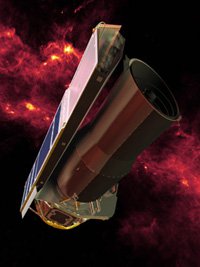Projects
Spitzer

The Spitzer Space Telescope (formerly SIRTF, the Space Infrared Telescope Facility) was launched into space by a Delta rocket from Cace Canaveral, Florida on 25 August 2003. During its mission, Spitzer obtained images and spectra by detecting the infrared energy, or heat, radiated by objects in space between wavelengths of 3 and 180 microns (1 micron is onemillionth of a meter). Most of this infrared radiation is blocked by the Earth's atmosphere and cannot be observed from the ground. Observations in the infrared allow Spitzer to see objects which are either too cold or too cloaked in dust to be well-studied at other wavelength bands. In addition, the cosmic redshift imposed by the expansion of the Universe shift visible and infrared light from the most distant stars and galaxies into Spitzer’s infrared bands.
Equipped with a 0.85-meter telescope and three cryogenically-cooled science instruments, Spitzer derived is great scientific power from the combination of a cold telescope in space with highly sensitive, state of the art, detector arrays. Spitzer at launch carried about 50 Kg of liquid helium which cooled the telescope to temperatures as low as ~5K. In May, 2009, following exhaustion of the helium, the telescope warmed up to ~25K but operations continued until January 2020, using Spitzer’s shortest wavelength detector arrays at 3.6 and 4.5um.
The scientific results from Spitzer are reported in upwards of 9,000 published papers and summarized by Werner and Eisenhardt in their book More Things in the Heavens (Princeton University Press, 2019). Although Spitzer touched on all areas of astrophysics, it made particularly significant contributions to the study of exoplanets – plaents around other stars. Spitzer was the first telescope to measure light from exoplanets. Spitzer also provided fundamental new data about the formation of stars and planetary systems, both within our own Milky Way galaxy and in galaxies far back in space and time, probing back to an era when the Universe was well less than 10% of its current size and age. The legacy of Spitzer lives on it the archive of its data which is available at the Infrared Science Archive, IRSA, on the Caltech campus.


